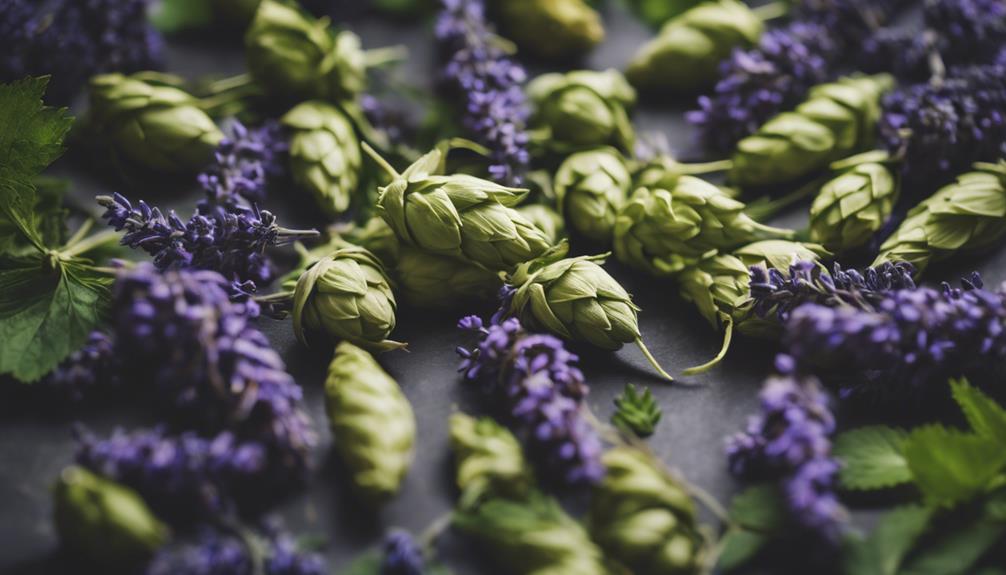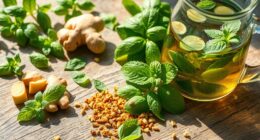In seeking relief from muscle tension, consider Valerian Root, Passionflower, Scullcap, Ginger, Wood Betony, Black Cohosh, Hops, Devil's Claw, and Arnica. Valerian Root provides calming benefits and reduces anxiety. Passionflower acts as a muscle relaxant, while Scullcap soothes spasms. Ginger's anti-inflammatory compounds reduce pain and stiffness. Wood Betony excels in muscle relaxation. Black Cohosh is known for easing spasms, and Hops offers sedative properties. Devil's Claw fights inflammation, and Arnica relieves joint pain. These herbs offer natural solutions for those enduring muscle tension, hinting at more to be discovered.
Key Takeaways
- Valerian root, passionflower, and scullcap are calming muscle relaxants.
- Ginger and wood betony relieve muscle tension and inflammation.
- Wild lettuce and black cohosh have natural muscle-relaxing properties.
- Hops and devil's claw are renowned for muscle relaxation and pain relief.
- Arnica, ginger, and turmeric offer higher absorption rates for muscle tension relief.
Valerian Root
Valerian root's calming and sedative properties make it a great choice for relieving muscle tension and promoting relaxation. This herb, commonly utilized in herbal medicine, is known for its ability to ease muscle tension by inducing a calming effect on the body.
The active compounds found in valerian root, including valerenic acid and valerone, interact with neurotransmitters in the brain, aiding in muscle relaxation. Studies have shown that valerian root not only helps reduce anxiety and improve sleep quality but also alleviates muscle spasms, making it a versatile remedy for various conditions related to muscle tension.
Valerian root can be consumed in different forms such as teas, tinctures, capsules, or extracts, providing individuals with options to incorporate this herb into their daily routines for muscle tension relief. Its efficacy in treating insomnia, restlessness, and nervous tension further solidifies its reputation as a go-to natural solution for promoting relaxation and easing muscle discomfort.
Passionflower

Passionflower is an herb renowned for its muscle relaxant and sedative properties. It is a valuable aid in alleviating muscle tension and stress. This natural remedy is effective in soothing muscle spasms and promoting relaxation, making it a popular choice for those seeking relief from discomfort.
Whether consumed in herbal supplements or teas, passionflower is a versatile option for supporting relaxation and easing muscle tightness.
Passionflower Benefits
Known for its calming effects on muscle tension and stress, passionflower is a natural muscle relaxant and sedative herb. This herb is highly regarded in herbal medicine for its ability to alleviate muscle spasms and tension effectively.
Passionflower is commonly used to promote relaxation and reduce muscle discomfort due to its muscle-relaxing properties. Whether consumed as a tea, tincture, or supplement, passionflower remains a popular choice for individuals seeking a natural remedy for muscle tension and relaxation.
Its sedative properties make it especially beneficial for those looking to unwind after a long day or ease the physical manifestations of stress. With its long-standing reputation as a muscle relaxant, passionflower continues to be a go-to option for individuals seeking a holistic approach to managing muscle tension and promoting overall well-being.
How to Use
To effectively utilize passionflower for muscle tension relief, consider incorporating it into your daily routine through various forms such as herbal supplements, teas, or tinctures. Passionflower is a renowned muscle relaxant and sedative that can help alleviate muscle tension and stress. By consuming passionflower in different forms, individuals can benefit from its calming properties and reduction of muscle spasms.
| Form | Description |
|---|---|
| Herbal Supplement | Convenient option for daily intake |
| Tea | Relaxing way to consume passionflower |
| Tincture | Concentrated form for quick absorption |
| Capsules | Easy dosage control for muscle tension relief |
Passionflower's effectiveness in easing muscle tension, promoting sleep, and reducing anxiety makes it a valuable herbal supplement. Remember, while passionflower is generally safe for short-term use, consulting a healthcare provider is advisable before integrating it into your routine. The herb's mechanism of action involves elevating GABA levels in the brain, leading to a calming effect on both the nervous system and muscles.
Scullcap

One of the medicinal herbs worth considering for relieving muscle tension is scullcap, known for its potent muscle relaxant properties. Scullcap is a natural muscle relaxant that can help alleviate muscle spasms and promote relaxation. This herb contains compounds that target the nervous system, reducing stress and anxiety levels. By acting on the nervous system, scullcap may aid in relieving symptoms of tension headaches and insomnia, offering a holistic approach to managing muscle tension-related issues.
Traditionally used to relieve muscle tension, scullcap is available in various forms such as tinctures, teas, and capsules, making it convenient for consumption. The muscle relaxant properties of scullcap make it a popular choice for those seeking natural remedies for muscle-related discomfort.
Incorporating scullcap into your wellness routine may provide relief from muscle tension and promote overall relaxation, offering a gentle yet effective solution for muscle-related issues.
Ginger

Ginger offers various benefits for relieving muscle tension. It contains anti-inflammatory compounds like gingerols and shogaols, which can effectively reduce pain and stiffness.
Furthermore, studies have shown that concentrated ginger extract can provide up to a 40% reduction in discomfort.
Ginger Benefits
With its important anti-inflammatory properties, ginger proves to be a valuable herb for relieving muscle tension. The presence of compounds like gingerols and shogaols in ginger contributes to reducing muscle soreness and stiffness.
Studies have demonstrated that highly concentrated ginger extract can effectively decrease pain and stiffness by up to 40%. Acting as a COX-2 inhibitor, ginger aids in alleviating pain commonly associated with muscle tension.
Additionally, the active components in ginger play a significant role in inhibiting oxidative stress, which further enhances its muscle-relaxing properties. Whether consumed as tea, in capsule form, or using the fresh root, ginger offers significant benefits for muscle relaxation.
Its role as a natural muscle relaxant makes it a popular choice for individuals seeking relief from muscle tension and discomfort. Incorporating ginger into one's routine can be a simple yet effective way to promote overall muscle health and well-being.
Ginger Usage
Utilizing ginger as a natural remedy for muscle tension offers a range of benefits due to its potent anti-inflammatory properties and ability to reduce pain and stiffness effectively. Ginger contains gingerols and shogaols, which act as anti-inflammatory agents, aiding in muscle tension relief.
Studies have demonstrated that highly concentrated ginger extract can notably diminish pain and stiffness by up to 40%, making it a valuable option for those seeking natural relief. Additionally, ginger acts as a COX-2 inhibitor, similar to certain medications, providing pain relief mechanisms.
This versatile herb can be consumed in various forms such as teas, capsules, or fresh root, making it accessible for different preferences. Furthermore, the compounds present in ginger play an important role in reducing oxidative stress, further enhancing its effectiveness in alleviating muscle tension.
Incorporating ginger into one's routine can be a practical and beneficial approach to managing muscle discomfort naturally.
Wood Betony

We've found that Wood Betony is a highly regarded herb known for its exceptional muscle-relaxing properties, which can effectively alleviate tension and discomfort in the body.
This herb, deeply rooted in herbal medicine practices, has been traditionally used to relieve muscle tension and promote relaxation.
As a nervine herb, Wood Betony exerts a calming influence on the nervous system, aiding in muscle relaxation. Its significant compounds play a vital role in delivering muscle-relaxing and tension-reducing effects, making it a popular choice for natural remedies targeting muscle tension, soreness, and achy joints.
- Wood Betony's muscle-relaxing properties make it a valuable herb for easing muscle tension.
- Traditional herbal medicine has long recognized Wood Betony for its ability to relieve muscle tension.
- As a nervine herb, Wood Betony calms the nervous system, contributing to muscle relaxation.
- Active compounds found in Wood Betony are responsible for its muscle-relaxing effects.
- This herb is commonly included in herbal formulations designed to alleviate muscle tension and discomfort.
Wild Lettuce

Wild Lettuce offers various benefits for relieving muscle tension, thanks to its natural muscle-relaxing properties. It can ease discomfort and promote relaxation.
When considering Wild Lettuce, it's important to understand the recommended dosage and usage to maximize its effectiveness in alleviating muscle spasms and stiffness.
Additionally, being mindful of potential side effects is vital to guarantee safe and proper utilization of this herb for managing muscle aches and tension.
Benefits of Wild Lettuce
When seeking relief from muscle tension, considering the benefits of Wild Lettuce can be advantageous. This herb, also known as Lactuca virosa, offers a range of benefits for muscle tension relief and relaxation. Here are some key benefits of Wild Lettuce:
- Sedative Properties: Wild Lettuce is traditionally used for its sedative effects, helping to calm the mind and body.
- Pain-Relieving Properties: The compound lactucopicrin found in Wild Lettuce has mild analgesic effects, making it effective in alleviating muscle tension.
- Muscle Spasm Relief: Wild Lettuce is known to ease muscle spasms, providing relief from discomfort and tension.
- Anxiety Reduction: This herb can help reduce anxiety levels, contributing to overall relaxation and well-being.
- Nervous System Calming: Wild Lettuce has a calming effect on the nervous system, making it a popular choice for managing muscle tension and promoting relaxation.
Incorporating Wild Lettuce into your routine may offer natural and effective support for relieving muscle tension and promoting relaxation.
Dosage and Usage
Considering the recommended dosage and usage guidelines for Wild Lettuce can help optimize its effectiveness in relieving muscle tension. Typically, a dosage of 30-60 drops of Wild Lettuce, diluted in water or juice, can be taken up to 3 times a day.
It's important to adhere to the dosage instructions provided by the manufacturer or a healthcare professional when using Wild Lettuce as a natural muscle relaxant. This herb is known to help ease muscle tension and promote relaxation, making it a popular choice for those seeking natural remedies.
Since individual tolerance and response to Wild Lettuce may vary, it's advisable to start with a lower dosage and adjust as needed. Consulting with a healthcare provider before incorporating Wild Lettuce into your routine is recommended, especially if you have underlying health conditions or are taking medications.
Prioritizing proper dosage and usage of Wild Lettuce can contribute to a safer and more effective experience in managing muscle tension.
Potential Side Effects
We must be mindful of the potential side effects associated with using Wild Lettuce for its sedative and pain-relieving properties. When considering incorporating this natural herb into your wellness routine, it's important to understand the possible drawbacks.
Here are some key points to keep in mind:
- Dizziness: Some individuals may experience feelings of lightheadedness or vertigo after consuming wild lettuce.
- Nausea: Another common side effect is nausea, which can lead to discomfort and unease.
- Vomiting: In more severe cases, wild lettuce intake could result in vomiting episodes.
- Allergic reactions: Individuals with sensitivities to plants in the Asteraceae family should use wild lettuce with caution to avoid allergic responses.
- Respiratory depression and toxicity: Excessive use of wild lettuce may have serious consequences such as respiratory issues and potential toxicity.
Before integrating wild lettuce or any herbal remedy into your health regimen, consulting a healthcare provider is important to ensure safety and appropriate dosage.
Black Cohosh

One herb known for its muscle relaxant properties and ability to relieve muscle tension is Black Cohosh. Studies suggest that Black Cohosh can help ease muscle spasms and reduce inflammation in the body, making it a promising option for those seeking natural muscle tension relief.
Despite its common association with alleviating menopausal symptoms, Black Cohosh has also shown efficacy in promoting muscle relaxation due to its muscle relaxant effects. Native Americans have a long history of using Black Cohosh for various medicinal purposes, including addressing muscle tension and discomfort.
The active compounds found in Black Cohosh, such as triterpene glycosides, are believed to play a key role in its muscle-relaxing effects. This herb's traditional use and scientific backing make it a notable option for individuals looking to manage muscle tension naturally.
Hops

Black Cohosh is renowned for its muscle relaxant properties; similarly, Hops also stand out in herbal medicine for their sedative and muscle relaxant characteristics.
Hops contain compounds like humulones and lupulones that contribute to their calming effects, making them a popular choice for relieving muscle tension and anxiety. The calming effects of hops not only help in reducing muscle tension but also promote relaxation, making them beneficial for overall well-being.
Additionally, hops are often used in herbal remedies and supplements to support muscle relaxation and improve sleep quality. Here are some key points about hops:
- Hops are commonly used in herbal medicine for their sedative and muscle relaxant properties.
- Compounds like humulones and lupulones in hops contribute to their calming effects.
- Hops can help relieve muscle tension, anxiety, and promote relaxation.
- The calming effects of hops make them beneficial for improving sleep quality and reducing stress.
- Hops are often used in herbal remedies and supplements to support muscle relaxation and overall well-being.
Devil's Claw

Known for its anti-inflammatory properties, Devil's Claw is a perennial flower native to Europe and Siberia. This herb is highly regarded for its ability to relieve muscle and joint pain due to the presence of lactones that exhibit potent anti-inflammatory effects. Devil's Claw works by inhibiting the activation of NF-kβ, a substance that triggers inflammation, thereby providing significant pain relief.
Research has demonstrated the efficacy of Devil's Claw in alleviating symptoms of osteoarthritis, with three out of four individuals experiencing improvements after supplementation.
For individuals seeking pain relief, liquid oral tinctures of Devil's Claw are recommended over tablets, as they're more readily absorbed by the body, enhancing the herb's effectiveness.
Arnica

Arnica, a perennial flower with anti-inflammatory properties, is commonly utilized for relieving muscle tension and joint pain. Liquid tinctures of arnica are particularly popular for their effectiveness in providing pain relief.
Here are some key points about arnica:
- Arnica is native to Europe and Siberia, where it's renowned for its anti-inflammatory properties.
- The lactones present in arnica contribute to its anti-inflammatory effects by inhibiting the activation of NF-kβ, an inflammatory substance.
- Studies have indicated that a significant number of individuals with osteoarthritis reported decreased pain levels after using arnica.
- In certain cases, arnica gel has shown to be more efficacious in relieving pain compared to NSAID Ibuprofen gel.
- Liquid oral tinctures of arnica are preferred by many due to their higher absorption rates, making them a go-to choice for muscle and joint pain relief.
Frequently Asked Questions
What Herb Is Good for Muscle Tension?
It is understood what herb is good for muscle tension. It's valerian root, passionflower, ginger, chamomile, and cayenne pepper. Valerian root eases tension with sedative properties. Passionflower relaxes muscles. Ginger reduces inflammation. Chamomile's flavonoids help with spasms. Cayenne pepper calms spasms with capsaicin.
What Herb Works as a Muscle Relaxer?
When looking for a natural muscle relaxer, consider valerian root, passionflower, chamomile, cayenne pepper, or peppermint oil. These herbs offer relief by easing muscle tension, calming spasms, and promoting relaxation, all without harsh chemicals.
What Is the Strongest Natural Muscle Relaxer?
We believe Valerian root stands out as the strongest natural muscle relaxer. Despite differing opinions, its sedative properties make it effective in easing muscle tension and promoting relaxation. Valerian root is a top choice.
How Do You Relieve Muscle Tension?
To relieve muscle tension, we can explore natural remedies like chamomile, cherry juice, and cayenne pepper, which are known for their relaxation properties. Supplements such as magnesium, valerian root, and passionflower, along with topical applications, can also help.
Conclusion
To sum up, integrating these 10 herbs into your routine may help alleviate muscle tension and promote relaxation. While individual results may vary, these natural remedies have been used for centuries to address a variety of ailments, including muscle discomfort.
It's always advisable to consult with a healthcare professional before adding new herbs to your regimen, to confirm they're safe and appropriate for your specific needs.










